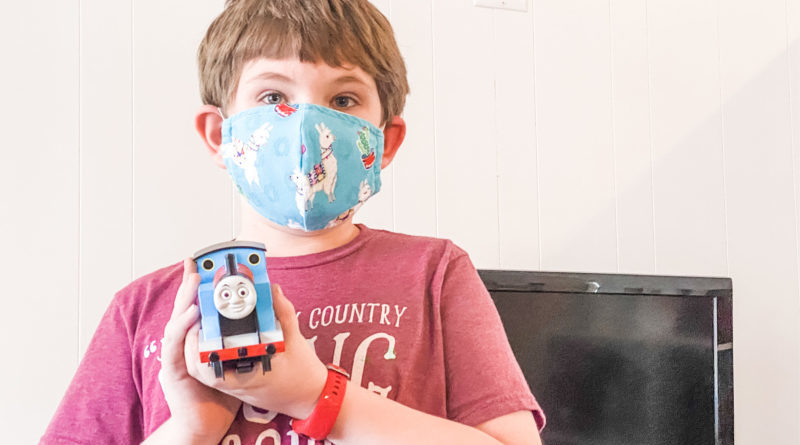Sheltered Diaries: Doing Your Homework on Safe Summer Activities
I have a confession to make: Last week we had our first playdate since shelter-in-place orders were given in March.
Tiny, like his father, is a bit of an extrovert. He understands the need to stay home, but he misses people – specifically, people his size who like the things he likes and don’t groan when they get up from sitting on the floor.
I’m more of an introvert, but even I am beginning to feel the wear of never seeing other people, too.
So I began asking public health experts – is there a way to playdate safely?
The answer was yes, but with a lot of caveats. A lot. And without them, I wouldn’t dream of scheduling any playdates at all.
Here’s how our playdate happened: Tiny has a friend at school, and they were missing each other mightily. Turns out, the friend lives down the street. After a series of increasingly less awkward conversations about social distancing protocols, the friend’s mom and I came to the same conclusion – neither family had been around anyone other than each other since March, and neither family had any plans to change that. The boys were physically within houses from each other.
Would it work?
We both were stealthily checking each other’s habits out, too, and slowly dropping hints to each other that we were taking all of this quarantining very seriously. Finally, Friday we agreed – the boys could play outside and have lunch in our backyard.
We explained the rules: No touching each other (high fives, side hugs, etc.) and wash hands before playing. The boys agreed, and the parents sat down to watch them play.
It was exactly what we all needed. We talked about what school would look like next fall, and whether we’d feel comfortable sending our kids back to school – and what it would take to make us feel comfortable. We talked about canceled vacations and plans to keep kids entertained during the long summer. We talked about how much both our boys needed to see another kid, even for a couple of hours.
The boys ran around the backyard, playing, splashing in the pool, and catching up.
Periodically, I’d hear something I realized later I hadn’t heard a lot of lately – silly giggles, the kind you only hear when two friends get together.
Later that day, after Tiny’s friend went home, the adults talked again, and forged an agreement: We’d make it through this summer together, agreeing that we’d each keep our socializing in person to our two families. Our kids would play together, we’d have the occasional meal together, and we’d work to keep it that way, and alert each other if anything changed.
Our decision was rooted in science – if both families are practicing strict social distancing, and only interact with each other, the risk is low. I wrote about it Monday, but scientists call it R naught – the average number of people one infected person can spread COVID-19 to in a vulnerable population.
Below one? That means, on average, an infected person doesn’t have access to very many people, and the chances of it spreading beyond that infection are low. A person with COVID-19 who is observing social distancing guidelines (and has been) will have little opportunity to infect anyone else.
When two R naught’s get together, the risk remains low. Not zero, but low. There is no such thing as a zero-risk outing because it’s in the name – novel coronavirus, meaning brand-spanking-new virus that we’re still learning about. If you’re in a high-risk category – someone older than 60, or with an underlying health condition – it’s probably still wise to not risk it at all.
Are you wondering what the risk is for other summer activities? This article from NPR also looks at the risk levels in various summer activities – including backyard gatherings, vacationing with another family, haircuts, and more.
The biggest pieces of advice?
- “We can think of transmission risk with a simple phrase: time, space, people, place,” said Dr. William Miller, an epidemiologist at Ohio State University, who explained that the more time you spend and the closer the space is, the higher your risk.
- The more people you interact with raises your risk.
- Indoors is riskier than outdoors.
- “Always choose outdoors over indoor, always choose masking over not masking, and always choose more space for fewer people over a smaller space,” said Dr. Emily Landon, a hospital epidemiologist and infectious diseases specialist at the University of Chicago Medicine.
- To make two-family gatherings safer, have everyone bring their own food, drink, and eating utensils.
- For pools, water will dilute any virus, but the real danger is in the getting to the pool from your car, and back. How many people will be waiting in line to come in? How closely will they adhere to the 6-foot distance? How many people will touch a turnstile or door before it’s wiped down? Will you be able to keep your children from interacting with other children at the pool – children you might not know and might not know how well their families have been maintaining social distancing?
What I loved about this article is that it gives the risk for the “perfect world” scenario where two uninfected families or people are interacting, and then what can alter that risk, which is extremely helpful when weighing the pros and cons of a potential activity.
It’s going to be a long summer without some of our favorite camps and activities, but hopefully, with a little ingenuity and a lot of advance work, we can still find ways to enjoy the warm weather.





